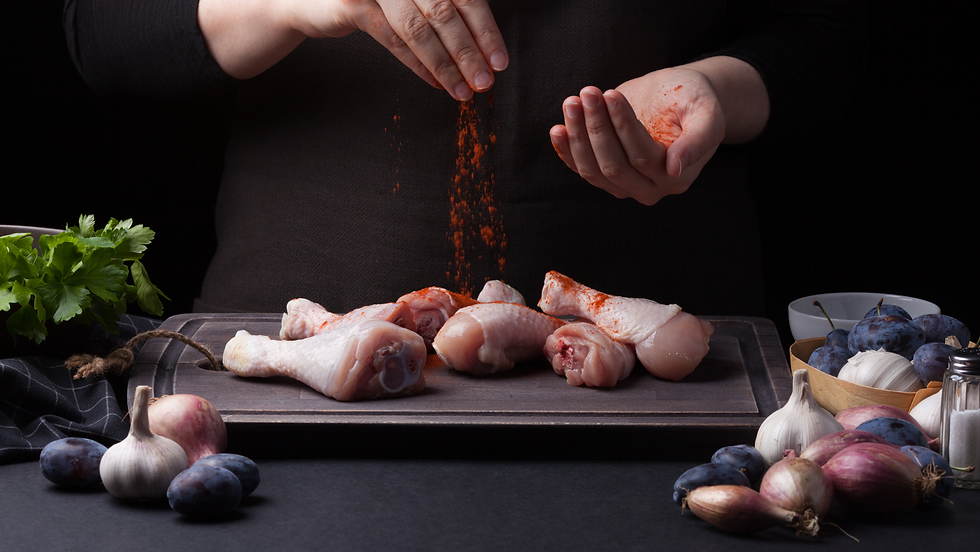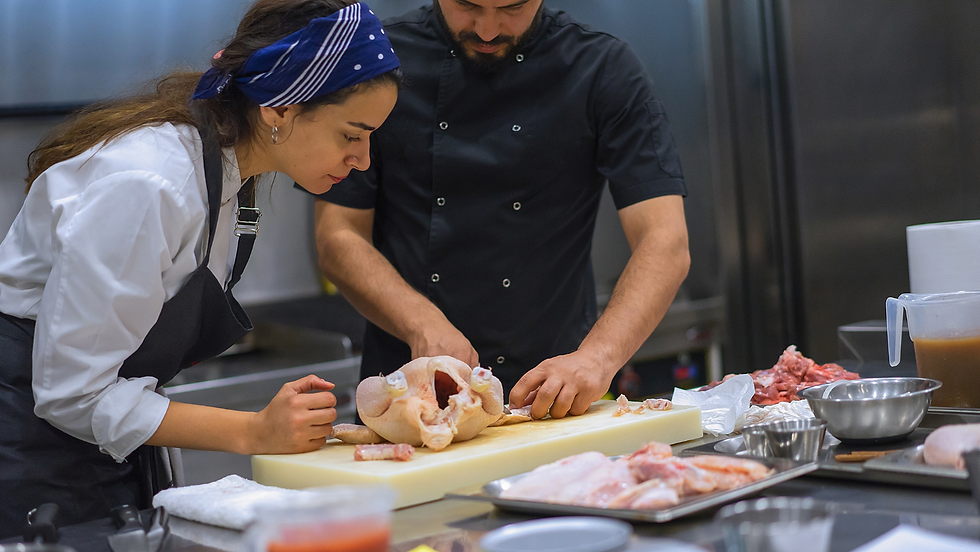Healthy Tips for Restaurants: Preventing Foodborne Illnesses
- eileen strauss
- Dec 11, 2023
- 10 min read

Foodborne illnesses like bacterial infection, food poisoning, and serious disease outbreaks affect over 48 million Americans every year causing the hospitalization of over 128,000 people and the deaths of over 3,000. Restaurants have a responsibility to the public to do everything possible to keep customers safe. When food safety is not preserved, not only are diners at risk, but so is the reputation of your business.
To avoid hefty penalties, lawsuits, and an interruption of operations, it is critical to consistently abide by food safety practices when serving customers.
Food safety guidelines are put in place to keep customers safe and prevent the risk of foodborne illness outbreaks, so it’s important for restaurants to establish protocols that meet the legal requirements for safe food handling. In this blog post, we'll outline the most important aspects of food safety to help you build an effective program for your business, pass your next health inspection, and keep your customers safe.
4 Golden Rules of Food Safety
Clean: Wash hands and kitchen surfaces often when handling food.
Separate: Handle raw animal protein separately. Never store poultry, seafood, and meat together.
Cook: Cook proteins completely until reaching a minimum internal temperature of 165 F. Electric probe thermometers are excellent for monitoring food temperature. Always insert the probe into the thickest part of the meat when ensuring that it is fully cooked.
Chill: Keep all inventory in a cool and dry place to keep bacteria at bay.

Food Safety Practices to Live By
Often caused by poor hygiene and improper food handling practices, a restaurant foodborne illness outbreak can be devastating. To keep your guests and business safe, we’ve put together this guide for preventing foodborne illness at your restaurant.
1. Maintain Personal Hygiene
Poor hygiene is one of the most common causes of foodborne disease. An outbreak can be prevented by establishing policies and following up with your staff regularly.
Handwashing: We all learned the importance of handwashing during the pandemic, but these practices should be followed on a daily basis, especially by food handlers. Washing hands is a crucial step in preventing the spread of germs that can cause a foodborne outbreak. A food handler who forgets to wash their hands just one time could be a recipe for disaster so it’s important to install fully-stocked handwashing stations in conveniently located areas. Train your staff on the correct way to wash their hands and post reminders at each hand sink.
Hygiene Practices: Personal cleanliness plays a major role in food safety. Soiled uniforms, dirty aprons, and uncovered hair can be sources of food contamination. A good hygiene policy should include the following practices:
Hair Restraints - Food handlers should always wear clean hats, hair restraints, and beard coverings.
Clean Work Uniforms - All uniforms and aprons should be laundered on a regular basis.
Jewelry - All jewelry should be removed before handling food as it can harbor germs and contaminate food.
Eating and Drinking - Train your staff not to eat or drink near food prep and service areas. Keep beverages in cups secured with a lid and straw.
Illness: Whenever an employee becomes ill, it poses a risk to your guests and the rest of your staff. Always take proper precautions with any illness, but be particularly vigilant when it comes to pathogens that are notorious for spreading foodborne illness including the following:
Norovirus - very contagious, often spread through hand-to-food contact
Shigella - spread by unwashed hands or contaminated water
Nontyphoidal Salmonella - linked to poultry, eggs, meat, and dairy
E. coli - linked to undercooked ground beef
Hepatitis A - not destroyed by cooking, handwashing is the best defense against this pathogen
Salmonella Typhi - linked to ready-to-eat food
Handwashing and cooking foods to the correct internal temperature are two of the most effective defenses against these foodborne pathogens. Staff members experiencing vomiting, diarrhea, or jaundice should be excluded from working until they receive a written release from a doctor.
Disposable Glove Use: When used properly, wearing single-use gloves is an effective precaution against illness. Hands must always be washed before putting on gloves and they should be changed regularly.
When to change single-use gloves:
After handling raw meat
Before touching ready-to-eat food
When gloves become dirty or torn
Before starting a new task
After 4 hours of use

2. Proper Food Handling/Avoiding the Danger Zone
Proper food handling starts when you receive a shipment of food and continues until the food is served. Every step along the way requires strict controls and constant monitoring.
Foods that require special handling, called TCS foods (time-temperature control for safety), provide a more hospitable environment for pathogens to grow at certain temperatures.
Throughout the steps below, TCS food should be kept out of the temperature danger zone, the range from 41 to 135 degrees Fahrenheit.
Receiving and Handling: Train your kitchen staff to be food-safe at all times throughout receiving, prepping, and cooking.
Inspect food shipments carefully and check temperatures. Frozen foods should be frozen solid on arrival. Ice crystals and water stains on the packaging are indications that the food may have thawed during transport.
Prevent cross-contamination by keeping foods separated, using color-coded kitchen tools, and cleaning and sanitizing equipment after every use. In addition to being spread by hands, germs can also be spread by contaminated foods, tools, and equipment. When raw foods like uncooked chicken come into contact with food prep surfaces like cutting boards, knives, and mixing bowls, pathogens can be left behind, potentially contaminating other foods.
Cooking Food Correctly - Cooking foods to the correct internal temperatures is another extremely important safeguard against the spread of foodborne pathogens. Some are spread by unwashed hands or utensils, but others may already be present in foods. To destroy these germs, foods must be cooked to a safe minimum temperature and tested with a clean, reliable thermometer.
Holding and Storage: Foods should be kept at safe temperatures throughout holding and storage.
Holding - Food holding is the practice of cooking foods ahead of time and holding them at a certain temperature. A soup that is made in the morning and stored in a soup warmer is being "hot-held.” If the temperature of the soup falls into the danger zone, however, pathogens can begin to grow to harmful levels. Foods that are hot or cold-held must be kept at safe temperatures and monitored to ensure that they do not enter the danger zone.
Cooling - Foods don’t have to be hot to be risky. Foods can also enter the temperature danger zone when they are not properly cooled. If hot dishes are prepared ahead of time and placed into cold storage to be reheated later, they must be cooled using a two-step process: food must be cooled from 135 degrees to 70 degrees F within 2 hours, then cooled from 70 degrees to 41 degrees Fahrenheit within 4 hours. To prevent the foods from lingering too long in the danger zone.
Food Storage - The method used to store foods also affects food safety. The FIFO (first in, first one) method pushes newer foods to the back of the shelf, and keeps the older foods in the front so they are used first. It’s critical that TCS foods are placed on cold storage shelves in a particular order to prevent liquids from dripping on the foods below, causing a potential contamination issue.
Correct Storage Order From Top-to-Bottom
Ready-to-eat foods
Seafood
Whole cuts of beef and pork
Ground meat
Whole or ground poultry
Keep Cutting Boards Separate: Foods containing animal products often contain bacteria, viruses and other microorganisms that are harmful to human health. Keeping cutting boards for raw food, cooked food, meat, and poultry items separate helps avoid cross contamination.

3. Cleaning and Sanitizing
It's a common misconception that cleaning and sanitizing are the same thing, but they are, if fact, two different methods, both crucial for maintaining a food-safe kitchen. Cleaning removes dirt and debris from a surface while sanitizing reduces pathogens on a surface.
How to Clean and Sanitize Food Contact Surfaces
Surfaces that don't come into contact with food only need to be cleaned and rinsed. But food-contact surfaces like prep tables, tools, and equipment must be cleaned and sanitized. Follow these steps to clean and sanitize correctly:
Wipe the surface to remove any crumbs or food particles
Wash the surface with an approved food-safe cleaning solution
Rinse the surface with clean water
Sanitize the surface with an approved sanitizing solution mix to the right concentration
Let the surface air dry
To keep food-contact surfaces free of pathogens, cleaning and sanitizing must be performed at the appropriate times. Train your staff to sanitize surfaces when they complete a task or start prepping a different food. They should also stop and sanitize if they are interrupted in their task and after using the same surface for 4 continuous hours.
Related Post: The Ultimate Cleaning Checklist
Cleaning and Sanitizing Equipment
Kitchen equipment is more challenging to clean and sanitize than a smooth surface like a prep table because there are moving parts. For the best sanitizing method, refer to the manual for each specific type of equipment. Follow our guidelines below for general equipment sanitizing:
Make sure the equipment is powered off and unplugged
Disassemble any removable parts
Wash all parts by hand or run through the dishwasher
Clean any food debris from equipment surfaces
Wash the equipment with an approved cleaner, rinse, then sanitize
Let parts and equipment air dry before reassembling

Follow Dishwashing Guidelines
Establish a dishwashing program for all the cookware, utensils, and tableware you use daily. Flatware, dinnerware, and glassware can be run through a dishwasher, but larger items like cooking pots and pans must be cleaned and sanitized manually in a three-compartment sink.
High Temp Dishwashers - These dishwashers use hot water to clean and sanitize dishes. To be effective at destroying germs, the water in the dishwasher must reach a temperature of 180 degrees Fahrenheit in the final rinse.
Chemical Dishwashers - Unlike a high-temp machine, a chemical dishwasher relies on chemical sanitizers to eliminate pathogens.
Three-Compartment Sinks - It's possible to clean and sanitize manually in a three-compartment sink, but only if the steps are performed correctly. Refer to our three-compartment sink guide to learn the best way to use this method.
Related Post: Secrets to a Spotless Restaurant Inspection

4. Maintain Pest Control
No one wants to think about pests invading their restaurant, but ongoing prevention is required to keep your business pest-free. Unwanted critters can not only damage your facility, but they are one of the worst spreaders of disease and foodborne illness.
To create a successful pest control program for your restaurant, keep these measures in mind.
Deny Access: Start by doing your best to prevent pests from gaining entry to your kitchen in the first place. Check all food deliveries carefully for potential hitchhikers and reject any and all shipments with signs of pest activity. Seal cracks, install door sweeps, and keep windows and vents screened off.
Deny Food and Shelter: Remove all temptations that attract pests to your facility. Take the garbage out throughout the day, keep trash receptacles clean, make sure dumpsters are always closed securely, and clean up spills, crumbs, and food debris immediately. It's also crucial to clean underneath equipment and never leave food out at night when pests are most active. This includes the dining room, front-of-house, and outside the restaurant as well as the kitchen area.
Work with a Licensed Pest Control Pro: If you've tried denying pests access, shelter, and food, but somehow they have found a way in anyway, it's time to call a professional. As soon as you see any signs of a pest infestation, no matter how small, find a licensed pest technician immediately. Do not attempt to do this yourself. A pest control pro will know exactly how to handle each pest in the safest and most effective manner.

5. Purchase Products from Approved Suppliers
You can do everything right and follow all the food safety protocols, but if the source of your food isn't reputable, you could have a big problem on your hands. This is especially true for foods like produce that doesn't get the benefit of high-heat cooking to destroy pathogens.
Lettuce can become contaminated by agricultural run-off water, for example. This type of contamination can't be removed by washing because the germs are actually inside the produce. This is why contaminated romaine lettuce outbreaks frequently make headlines. The only way to prevent this type of occurrence is to buy foods from an approved supplier.
Never buy from roadside vendors or local farmers unless they are approved as commercial suppliers.
Choose suppliers that meet the requirements of local, state, and federal laws.
Be especially picky when choosing suppliers of TCS foods.
Even when you purchase from a supplier you trust, inspect every shipment carefully and reject anything that looks suspicious.

6. Train and Monitor Staff
Your restaurant staff should undergo Food Safety training, covering everything from personal hygiene, cooking techniques, and proper food preparation to temperature monitoring, crisis management, and storage practices.
Follow Standard Operating Procedures: A standard operating procedure (SOP) is a term for a written rule or guideline. Putting procedures in writing is the best way to hold your staff accountable for following the policies of your food safety program. When writing SOPs, keep the following in mind:
Who will perform which task?
What supplies are needed to perform the tasks?
Where will the task be performed?
When should the task be performed?
How will the task be performed?
Train Your Staff: Once you have established all SOPs, begin training your staff. Your efforts will be more successful if you think of training as an ongoing operation, not a one-off obligation. New team members need to go through a training program during onboarding and existing employees can always benefit from a refresher course. Place visual aids like posters throughout your kitchen as helpful reminders.
Monitor Team Members: The only way to be sure that your SOPs are being followed is to establish monitoring procedures. Temperature checking is one of the most important examples of a monitoring procedure. Keep a written record that shows the date and time of the temperature check, the temperature of the food, and the initials of the employee who performs the check.
Require Food Handler Certification: One of the best ways to keep your team members educated is to require food handlers certification for all back-of-house employees, requiring at least one certified team member to be on staff at all times.

7. Know the Big 6 Pathogens
According to the CDC, 250 foodborne pathogens are the cause of many food-related illnesses in the US every year. Of that 250, six have been identified as being the predominant sources of outbreaks across the country. It's important for all food handlers to become aware of these pathogens so they can properly address and prevent them from harming your customers and negatively impacting your business.
FoodDocs, developers of AI-powered food safety-compliance software, has created a 100% free and downloadable Big 6 Pathogens Poster that you can print and display in your kitchen. Not only does the poster identify these harmful pathogens, but it is a great source for your staff, listing preventative measures they can take to avoid problems. Once printed and displayed, it is important to review it with current employees and make awareness a part of your onboarding process.
Related Posts
Checking it Twice: Preventative Maintenance for Restaurants

By Eileen Strauss




Comments